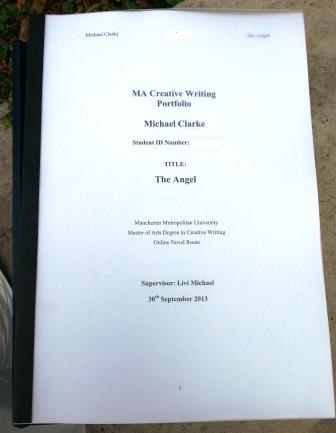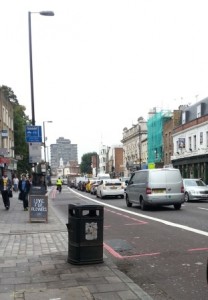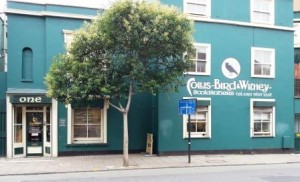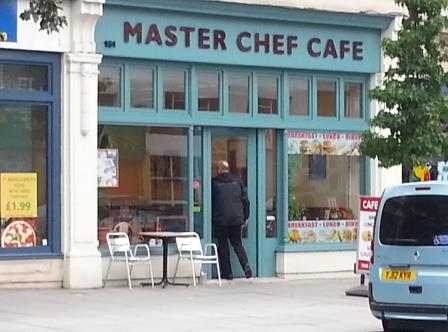It’s four weeks since the end of my intense period of editing that finished with me frantically e-mailing my novel manuscript to the printers and bookbinders and heading up the Holloway Road to have the satisfaction of picking up my own copies.
The printers sent two bound copies directly to Manchester Metropolitan University — who kept me in suspense a while before acknowledging receipt. I felt relieved when I eventually received a confirmation e-mail, although I now need to wait until late June to hear whether I’ve made the grade.
Many people I’ve spoken to about the course have been quite incredulous about this nine month delay in communicating students’ marks. It’s apparently because the awards committee only sits once a year (in the summer) and, as we part-time students are given until the start of the next academic year to write our novels, we have to wait for our marks to be confirmed when all the conventionally scheduled English and Creative Writing courses are assessed at the end of 2013-4.
(Since submitting the novel I’ve now heard that MMU have changed their schedule so they intend to give us our marks and feedback by mid-January next year — at which point we should know whether we’re going to graduate but will still have to wait until the summer for it to be official.)
While it would be nice to be able to put the letters MA after my name (should I pass) it’s been the process of taking the course that’s been of much more value to me than gaining the qualification.
After all, agents and publishers don’t look at the Creative Writing MA on a graduate’s CV and immediately decide to your manuscript will do the business for them.
But the process of taking the course and sticking with it to the end ought to show evidence of many desirable qualities in a writer. At York Festival of Writing, one agent in particular told me how much she likes Creative Writing MA students and graduates. Other agents have also said that a mention of an MA in a covering letter means that will give a submission more serious consideration on the grounds that the writer has invested time and money in improving their own writing.
Completing an MA course should demonstrate:
- The standard of your writing as a whole has met (and maintained) the quality criteria of the course admissions tutor — for the MA I needed to have my own creative writing assessed as well as a piece of criticism
- The potential to take a professional attitude towards your writing — motivation and enthusiasm are some of the qualities that are examined in the interview process. Also, students on an MA course have to be able to take and receive criticism and feedback from both students and tutors
- An ability to deliver work to deadlines — not only the final novel but several other pieces of academic work must be submitted on time. There are also many other dates that that have to be met — when it’s your turn to distribute a 3,000 word extract for discussion — or to send another writer feedback on their work. The MMU course was structured so that, at times, each student was expected to provide a new section every second or third week — it could be an intense schedule.

- You can write a novel! At the end of the course, at least for MMU, you should have a work that’s potentially publishable that can be before an agent — if you don’t you’ll fail.
Unlike the MMU course, not all MA courses insist on a novel length piece of work be submitted as a final assessment. Given that the MMU 60,000 minimum word count is about four times the length of a typical academic Masters level dissertation then some courses might not consider this length of assessment necessary (in terms of course credits the novel forms 60 out of 180 points overall — only 20 more than the much shorter Transmission project).
But it’s been the experience of writing a novel-length piece that’s been the most valuable aspect of the course for me and it’s by completing the draft, going back and revising and altering and grappling with the many tentacled octopus that has taught me lessons that can’t be taught as theory.
I’ll be much better prepared to write the next novel purely by pushing myself through the experience of completing The Angel and, in that regard, MMU’s decision to devote the third year of the course to independent writing with one-to-one support from a tutor might ultimately teach students as much as in the more formally taught sections of the course.
I found an interesting blog post by Andrew Wille, who was a ‘book doctor’ at the York Festival of Writing: Learning And Studying And Writing: A DIY MA In Creative Writing . It’s worth reading the post for his list of recommended writing books, including several I’ve read such as the excellent Francine Prose’s Reading Like A Writer, Harry Bingham’s pragmatic How to Write, the amusing How Not To Write A Novel and the ubiquitous Stephen King book.
Andrew Wille has substantial experience of teaching and studying writing and argues that any novel submitted for a Creative Writing MA will need substantial revision before it’s commercially publishable (and often more than one redrafting).
Having gone through the MA experience I don’t disagree — read the comments after his blog post and you’ll see a conversation between us on the subject.
Despite the apparently leisurely deadline, I’d guess that most of the novels submitted for MA deadlines only come together very near the end of the writing process as long, organic, rich works formed of interdependent strands. Their writers might therefore benefit from a period of reflection at the complexity of the work they’ve created.
And the writers wouldn’t likely to be taking an MA if it wasn’t the first time they’d worked so seriously on a novel to the point of its completion. So any MA novel is likely to undergo plenty of changes if it’s taken up by an agent and publisher — but at least the novel exists.
It’s probably inevitable from workshopping in 3,000 and 5,000 words discrete segments for the MA course and writing groups that the finished work when it’s put together bears a risk of repetition.
When writing sections to be presented out of context, it’s difficult not to anticipate comments and questions from readers who may have last encountered the story weeks or months ago: there’s a temptation (perhaps unconscious) to drop in a piece of exposition or dialogue that illustrates just why a certain character might behave in a particular way or to establish setting or theme.
It’s not too difficult to spot the blatant repetitions but it’s harder to identify actions or dialogue in scenes that perhaps do the same job as examples in other sections but do so in subtly different ways. It’s a tough judgement call to cull these, especially when they might be also serving another purpose in the novel. It’s another example of where workshopping in sections doesn’t recreate the experience of a ‘real world’ reader who’d hopefully have conjured up their own unique interpretation of the novel having read the novel as a continuous whole.
On the other hand, to avoid embarrassing themselves with work littered with typos, clumsy phrasing and bad grammar, I’ve noticed that most students and writing group participants will polish the extracts they present for workshopping to a standard that’s far above first draft.
I tend to write a first draft, print it, revise it on paper, make alterations in the manuscript, then read it aloud again and proof-read before I’ll send the work out for comment. That’s more like third or fourth draft — and still typos creep through. But this ought to mean — in addition to the copy editing and proof reading before the final submission — that novels produced on MA courses are probably presented in a more respectable state than the average manuscript an agent will receive, even if structural changes are required.
I hinted in the last blog post that the location of my novel/dissertation printers on the Holloway Road was a little serendipitous. It’s because the famously grimy, largely down-at-heel north London road was often my route to City University for the Certificate in Novel Writing — and it’s likely many of the ideas that formed the conception of the novel were mulled over while stuck in its traffic jams.
My journey down the Holloway Road started from a grotesquely ugly office block where I was working at the time which was stranded in the middle of a housing estate on the very margins of Luton.

While I’m sure the local area was a perfectly acceptable place to live — it was one of the more desirable areas of Luton — it wasn’t exactly thrilling as a location to spend one’s working day. The only ‘entertainment’ nearby was an Asda and a small parade of local shops containing an Iceland, various takeaways and an estate pub.
Nevertheless, the Asda had quite a sizeable book section and I used to think (and still do) that it would be a great ambition to have a book of mine on sale there. Of course Foyles on Charing Cross Road or Waterstones on Piccadilly would be great, as would all the wonderful independent booksellers, but making it to the shelves of Asda in Luton would make a different sort of statement.
At lunchtimes I escaped by running around the pleasant country lanes that lay beyond the suburban sprawl. I sometimes did a bit of writing in the office and remember getting inspiration for a poem I wrote for an OU course from all the plastic carrier bags being blown into the branches of trees in the scrubby wasteland behind the office — it was that kind of place.

It was the safe, uniform suburban location that, for different reasons, would drive both the leading characters in the novel absolutely crazy — and in retrospect the city versus country conflict and the themes of escape and ambition in the novel may well be rooted in the journey from Luton to Islington.
When I was working in the office, I’d leave on Mondays and Wednesdays around five, drive past the airport, barrel down the M1, then take the A1 through Henlys Corner and under the bridge at Archway, from where I had a glimpse of one of those marvellous, tantalising views where London suddenly reveals itself — the Gherkin, Tower 42, Barbican and other City towers (the Shard was yet to be built) rising in the distance.
Then it was a crawl along the Holloway Road, dodging buses and stopping at traffic lights every hundred yards, but I got to know the road well — the tube station, the bizarre architecture of the London Metropolitan University’s new extension, the art deco Odeon and the Wetherspoon conversion of the Coronet cinema.
Holloway Road shares similar characteristics to other areas adjoining large football grounds — a lot of rather folorn looking takeaways and pubs that do most of their business on match-days.
Once I drove obliviously down the road just before an Arsenal Champions’ League game. Even taking my usual shortcut down Liverpool Road to avoid Highbury and Islington roundabout and Upper Street, I was caught between coaches and police vans and ended up a stressed three-quarters of an hour late for the City tutorial.
So the Holloway Road represented the twice-weekly transition I made from the Home Counties to the centre of London — the scruffy but vital artery that connected the inner-city cool of Islington and slightly edgy Finsbury, where City University’s campus is located in the middle of one of the closest pockets of social housing to the centre of London.
Many other routes in and out of London are fast dual-carriageways or even rise on viaducts above the zone two fringes, like the A40 Westway that I normally used to drive home. Unlike these, the traveller on the A1 Holloway Road experiences the grinding pace of city life. While nowhere near as hip, it’s not too unlike the Great Eastern Street/Commercial Street area that features in the novel.

The place also has associations with the City course as one of the students set part of her novel in the area. She wrote beautifully and she described very evocatively the experience of living just off the Holloway Road, albeit a few years ago when it perhaps held its connections with the lost London of the mid-20th century a little more strongly (there was a famous eccentric department store whose name escapes me). But the writing confirmed a sense of latent oddball seediness — an area in a liminal zone between gentrified Islington and Highgate and the grittier localities, generally to the east.
The road does seem to have something of a middle-class foothold amongst the seediness — with even a Waitrose in its smartest sections. However, the Highbury and Islington end is still more kebab house than cup cake.

So it was oddly appropriate that over three years later when the novel was finished (in its MA submission form) that it would be printed right next to the road I’d regularly driven down when I first started writing it. Collis, Bird and Withey, whose service overnight service I’d recommend, are just in the shadow of the Emirates Stadium (and I’ve made James an Arsenal fan in the novel).
And as a further little co-incidence bonus, I walked past this cafe below on the way back to the tube station with my bound manuscripts in hand. Anyone who’s read the start of the novel will spot the reason.

